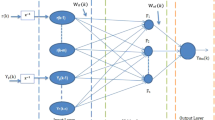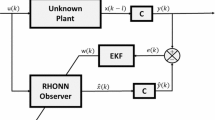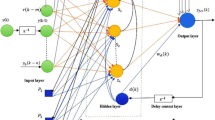Abstract
Recently, the study of dynamic systems and signals in the frequency domain motivates the emergence of new tools. In particular, electrophysiological and communications signals in the complex domain can be analyzed but hardly, they can be modeled. This problem promotes an attractive field of researching in system theory. As a consequence, adaptive algorithms like neural networks are interesting tools to deal with the identification problem of this kind of systems. In this study, a new learning process for recurrent neural network applied on complex-valued discrete-time nonlinear systems is proposed. The Lyapunov stability framework is applied to obtain the corresponding learning laws by means of the so-called Lyapunov control functions. The region where the identification error converges is defined by the power of uncertainties and perturbations that affects the nonlinear discrete-time complex system. This zone is obtained as an alternative result of the same Lyapunov analysis. An off-line training algorithm is derived in order to reduce the size of the convergence zone. The training is executed using a set of some off-line measurements coming from the uncertain system. Numerical results are developed to prove the efficiency of the methodology proposed in this study. A first example is oriented to identify the dynamics of a nonlinear discrete time complex-valued system and the second one to model the dynamics of an electrophysiological signal separated in magnitude and phase.













Similar content being viewed by others
References
Aibinu A, Salami J, Shafie A (2010) Determination of complex valued parametric model coefficients using artificial neural network technique. Adv Artif Neural Syst 2010:11
Aizenberg I (2011) Complex valued neural networks with multi-valued neurons. Springer, Berlin
Aizenberg N, Ivaskiv L, Pospelov A (1971) About one generalization of the threshols function. Dokl Akad Nauk 196(6):1287–1290
Axler S, Ribet KA (2010) Complex analysis. Springer, New York
Benvenuto N, Dinis R, Falconer D, Tomasin S (2010) Single carrier modulation with nonlinear frequency domain equalization: an idea whose time has come-again. Proc IEEE 98(1):69–96
Benvenuto N, Piazza F (1992) On the complex backpropagation algorithm. IEEE Trans Signal Process 40(4):967–969
Chairez I (2009) Wavelet differential neural network. IEEE Trans Neural Netw 20:1439–1449
Cotter NE (1990) The stone-weierstrass theorem and its application to neural networks. IEEE Trans Nueral Netw 1(4):290–295
Dong-Chul P, Tae-Kyun J (2002) Complex bilinear recurrent neural network for equalization of a digital satellite channel. IEEE Trans Nueral Netw 13(3):711–725
Egmont-Petersen M, Ridder D, Handels H (2002) Image processing with neural networks: a review. Pattern Recognit 35(10):2279–2301
Freeman RA, Kokotovic PV (2008) Robust nonlinear control design. Birkhauser, Boston
Georgiou G, Koutsougeras C (1992) Complex domain backpropagation. IEEE Trans Circuits Syst 39(5):330–334
Gompper G, Ihle T, Kroll D, Winkler RG (2008) Advances in polymer science, chap. multi particle collision dynamics: a particle-based mesoscale simulation approach to the hydrodynamics of complex fluids. Springer, Berlin
Han S, Lee K (2010) Robust friction state observer and recurrent fuzzy neural network design for dynamic friction compensation with backstepping control. Mechatronics 20(3):384–401
Hernandez-Vargas E, Alanis A, Sanchez E (2012) Discrete-time neural observer for hiv infection dynamics. In: World Automation Congress (WAC)
Hirose A (2012) Complex valued neural networks. Springer, Berlin
Hussain Z, Sadik A, Shea P (2011) Digital signal processing and introduction with mathlab and applications, chap. 2 Discrte and digital signals and systems. Springer, Berlin
J D, Sundararajan N, Saratchandran P (2002) Communication channel equalization using complex valued minimal radial basis function neural networks. IEEE Trans Neural Netw 13(3):687–696
Kim T, Adali T (2003) Approximation by fully complex multilayer perceptrons. Neural Comput 15(7):16411666
Kobayashi M, Yamazaki H (2003) Information geometry of complex-valued boltzmann machines. IEICE Trans Fundam Electron Commun Comput Sci J87–A(8):1093–1101
Kuroe Y (2003) Complex-valued neural networks: theories and applications, chap. a model of complex-valued associative memories and its dynamics. World Scientific Pub Co Inc., River Edge
Lakshmikantham V, Matrosov VM, Sivasundaram (1991) Vector Lyapunov functions and stability analysis of nonlinear systems. Kluwer, Amsterdam
Lee S, Mandic D (2006) An augmented extended kalman filter algorithm for complex-valued recurrent neural networks. In: IEEE International Conference on Acoustics, speech and signal processing (ICASSP)
Lee Goh S, Mandic DP (2004) A complex-valued rtrl algorithm for recurrent neural networks. Neural Comput 16(12):2699–2713
Lee Goh S, Mandic DP (2007) An augmented crtrl for complex-valued recurrent neural networks. Neural Netw 20:1061–1066
Leung H, Haykin S (1991) Complex domain backpropagation. IEEE Trans Signal Process 39(9):2101–2104
Mandic D, Su Lee Goh V (2009) Complex valued nonlinear adaptive filters. Wiley, Chichester
McLachlan MW (2010) Complex variable theory and transform calculus: with technical applications. Cambridge University Press, Cambridge
Nitta T (1997) An extension of the back-propagation algorithm to complex-numbers. Neural Netw 10(8):1391–1415
Nitta T (2000) And analysis of the fundamental structure of complex valued neurons. Neural Process Lett 12:239–246
Noest AJ (1988) Discrete-state phasor neural networks. Phys Rev A 38:2196–2199
Noest AJ (1988) Phasor neural networks. Neural information processing systems. AIP, New York, pp 584–591
Oppenheim A, Lim J (1981) The importance of phase in signals. Proc IEEE 69(5):529–541
Peng M, Chen S, Guanglin Y (2012) Proceedings of the international conference on information engineering and applications, chap. 74 Sparser signals and compressive sampling based on FFT and DWT Peng. Springer, London, pp 619–624
Poznyak A, Sanchez E, Yu W (2001) Differential neural networks for robust nonlinear control (identification, state estimation an trajectory tracking. World Scientific, River Edge
Poznyak AS, Medel J (1999) Matrix forgetting factor. Int J Syst Sci 30(2):165–174
Rizek S, Kucera M (1999) Hard-limits neural nets with electrooptical elements. Neural Netw World 9(6):417–487
Salgado I, Chairez I (2009) Discrete time recurrent neural network observer. In: 2009 International Joint Conference on Neural Networks, pp 909–916
Salgado I, Chairez I (2013) Discrete-time recurrent neural network observer. Neurocomputing 101:73–81
Tanaka T, Mandic D (2007) Complex empirical mode decomposition. IEEE Signal Process Lett 14(2):101–104
Wang Z, Liu Y, Liu X (2009) State estimation for jumping recurrent neural networks with discrete and distributed delays. Neural Netw 22(1):41–48
Wen S, Zeng Z, Haung T, Chen Y (2013) Passivity analysis of memristor-based recurrent neural networks with time-varying delays. J Frankl Inst 350(8):2354–2370
Xia Y, Jelfs B, Van Hulle MM, Principe J, Mandic DP (2011) An augmented echo state network for nonlinear adaptive filtering of complex noncircular signals. IEEE Trans Neural Netw 22:74–83
Zhou J, Gao S (2013) An esperimental study on the auto-association neural network with electronic image processing. LNEE 178(3)(1):395–401
Author information
Authors and Affiliations
Corresponding author
Rights and permissions
About this article
Cite this article
Alfaro-Ponce, M., Salgado, I., Arguelles, A. et al. Adaptive identifier for uncertain complex-valued discrete-time nonlinear systems based on recurrent neural networks. Neural Process Lett 43, 133–153 (2016). https://doi.org/10.1007/s11063-015-9407-8
Published:
Issue Date:
DOI: https://doi.org/10.1007/s11063-015-9407-8




